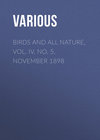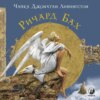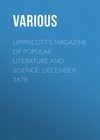Kitabı oku: «Birds and All Nature, Vol. IV, No. 5, November 1898»
NATURE'S ORCHESTRA
ALL nature is attuned to music. Man may seek the fields, the forests, the mountains, and the meadows, to escape from distracting noises of the city, but nowhere, not even in the depths of mountain forests, will he find absolute silence. And well for him that it is so, for should no noise, no vibration of the air greet his accustomed ear, so appalling would be the dead silence that he would flee from it as from the grave.
Even the Bugs make music. They may not be much as vocalists but they take part in nature's symphony with the brook, the Bird, and the deep diapason of the forest monarch swaying and humming to the gusts of the wayward wind. It is true that the great majority of our species of insects are silent, and those which do make sounds, have not true voices, breathing as they do through holes arranged along each side of their body, and not through their mouths, they naturally possess no such arrangement for making noises connected with breathing as we find in the human larynx.
The "buzzing Fly" and "droning Bee" are classed among nature's musicians, as well as the Cicadas, Grasshoppers, Crickets, Locusts, Katydids, and Beetles. Only the males are the musicians in the insect families – with the exception of the Mosquito, the lady being the musical member of that family – and the different kinds of Grasshoppers are provided with an elaborate musical apparatus by means of which they call their mates.
Chief among the insect performers is the Cicada, often confused with the Locust, though he does not belong to that family at all, who possesses a pair of complicated kettle-drums, which he plays with his muscles instead of sticks.
Directly behind the base of each hind leg is a circular plate of about one-quarter of an inch in diameter. Beneath each of these is a cavity across which is stretched a partition of three membranes. At the top is a stiff, folded membrane, which acts as a drum-head. Upon this he plays with his muscles, the vibrations being so rapid that to the ears of some listeners the noise, or music he engenders, sounds more like that of a mandolin than a drum. He is a black fellow with dull green scroll work over his thick body, lives in trees, and is generally invisible when he plays the drum.
The Grasshopper is the fiddler of the great orchestra, and the hotter the day the more energetically does he fiddle. The fellow with the short horns has a rough hind leg which he uses as a bow; this he draws across the wing cover, giving off the notes which he so dearly loves. Near the base of each fore wing is a peculiar arrangement of veins and cells. This arrangement differs in the different species, but in each it is such that by rubbing the fore wings together they are made to vibrate, and thus, some naturalists aver, they make the sounds which we hear.
The most easily observed of all insect musicians are the common Crickets. By placing a sod of growing grass in a cage with several male crickets, you can watch them play upon their fiddles. Upon the lower side of their wings you will see ridges like those of a tiny file, and on the inner margin toward the base from the end of the principal vein, a hardened portion, which may be called the scraper. By using the files and scrapers of their fore wings the little musicians add their notes to the universal music of the world. Ellanora Kinsley Marble.
A LITTLE BIRD
A little Bird in a tree
Made one – a man and maiden three.
'Twas not by chance that they had met!
"None see," they said; one can forget
A little Bird.
A long hot road, a strip of grass,
'Twould tempt the Fates to let it pass!
Two people linger in the walk;
There's only one to hear them talk,
A little Bird.
Long shadows stretched across the sky,
Two people parted with a sigh,
But there was no one there to see!
How do I know? and who told me?
A little Bird.
– E. R. C.
THE TURKEY'S FAREWELL
I go, but I return.
The fiery furnace has no horrors for me.
Mine is a race of martyrs. I can trace
Ancestors by the score who laid their heads
Upon the axman's block. It is a little way
We have. Why should I care to flaunt
My feathered beauty on a bare November bough?
I shall appear again in a far richer dressing.
In years to come it will be said of me,
As of my ancestors, that nothing in my life
Shed so much glory as the leaving of it.
Full many a little child that now
Is prattling at its grandma's knee shall say
In future years that of all days it holds
In the most sacred memory the one
When it officiated at
The funeral of this Turk. And now
Lest some one shall say I knew not how to die,
Let the ax fall.
BIRDS
THE BIRD is little more than a drift of the air brought into form by plumes; the air is in all its quills, it breathes through its whole frame and flesh, and glows with air in its flying, like a blown flame; it rests upon the air, subdues it, surpasses it, outraces it —is the air, conscious of itself, conquering itself, ruling itself.
Also, into the throat of the Bird is given the voice of the air. All that in the wind itself is weak, wild, useless in sweetness, is knit together in its song. As we may imagine the wild form of the cloud closed into the perfect form of the Bird's wings, so the wild voice of the cloud into its ordered and commanded voice; unwearied, rippling through the clear heaven in its gladness, interpreting all intense passion through the soft spring nights, bursting into acclaim and rapture of choir at daybreak, or lisping and twittering among the boughs and hedges through heat of day, like little winds that only make the Cowslip bells shake, and ruffle the petals of the Wild Rose.
Also, upon the plumes of the Bird are put the colors of the air; on these the gold of the cloud, that cannot be gathered by any covetousness; the rubies of the clouds, the vermilion of the cloud-bar, and the flame of the cloud-crest, and the snow of the cloud, and its shadow, and the melted blue of the deep wells of the sky – all these, seized by the creating spirit, and woven into films and threads of plume; with wave on wave following and fading along breast and throat and opened wings, infinite as the dividing of the foam and the sifting of the sea-sand; even the white down of the cloud seeming to flutter up between the stronger plumes, seen, but too soft for touch. – Ruskin.
BIRDS IN STORMS
DURING windstorms birds may sometimes be seen flying overhead at a great height. When this is observable, it is said it may be taken for granted that the upper atmosphere is comparatively quiet, and the disturbance is confined chiefly to the lower regions. Many seabirds seek the upper air of comparative quietness during tropical hurricanes. A writer in the Boston Transcript says that when a heavy wind or gale springs up, the Gulls, Terns and Petrels will fly back and forth over the water's surface, rising and falling, and uttering their peculiar cries of warning. If the storm extends too high up they will drift gradually with the wind, or fly away on the edge of the hurricane. Very often they get caught unexpectedly in the gales of wind, and they find themselves in a dangerous position. Then they struggle with might and main against the powers of the air currents. Knowing that danger and death face them if they once come under the dominion of the wind, they use all the strength and tactics they are capable of to combat the elements. A young Herring Gull, a Petrel, or a Tern thus surprised will beat up against the wind with powerful flight. It will rise high in the air, facing the gale, and making a little progress forward as well as upward. Then it will suddenly descend with rapid flight toward one side of the storm-swept path, but falling off at the same time in the direction of the blowing wind. Once more it will sweep around and face the storm, ascending heavenwards and striking desperately out toward the direction of the storm. By pursuing these tactics, the bird will gradually work itself to one side of the storm centre.
THE SLEEPING-PLACES OF BIRDS
IT IS difficult to imagine a spot with fewer domestic features to adorn the home than a piece of the bare ceiling of a tropical veranda; but the attachment of animals to their chosen sleeping-places must rest on some preference quite clear to their own consciousness, though not evident to us. In some instances the ground of choice is intelligible. Many of the small blue British Butterflies have grayish spotted backs to their wings. At night they fly regularly to sheltered corners on the chalk downs where they live, alight head downwards on the tops of the grasses which there flourish, and closing and lowering their wings as far as possible, look exactly like seed-heads on the grasses. If the night is cold they creep down the stem and sleep in shelter among the thick lower growth of grass. The habits of birds in regard to sleep are very unlike, some being extremely solicitous to be in bed in good time, while others are awake and about all night. But among the former the sleeping-place is the true home, the domus et penetralia. It has nothing necessarily in common with the nest, and birds, like some other animals and many human beings, often prefer complete isolation at this time. They want a bedroom to themselves. Sparrows, which appear to go to roost in companies, and sometimes do so, after a vast amount of talk and fuss, do not rest cuddled up against one another, like Starlings or Chickens, but have private holes and corners to sleep in. They are fond of sleeping in the sides of straw-ricks, but each Sparrow has its own little hollow among the straws, just as each of a flock of sleeping Larks makes its own "cubicle" on the ground. A London Sparrow for two years occupied a sleeping-home almost as bare of furniture as the ceiling which the East Indian Butterfly frequented. It came every night in winter to sleep on a narrow ledge under the portico of a house in Onslow Square. Above was the bare white-washed top of the portico, there were no cosy corners, and at eighteen inches from the Sparrow was the gas-lit portico lamp. There every evening it slept, and guests leaving the house seldom failed to look up and see the little bird fast asleep in its enormous white bedroom. Its regular return during two winters is evidence that it regarded this as its home; but why did it choose this particular portico in place of a hundred others in the same square? —Spectator.
Bird Courtships. – When he (the Flicker) wishes to charm his sweetheart he mounts a very small twig near her, so that his foreparts shall not be hidden as he sits upright in regular Woodpecker attitude, and he lifts his wings, spreads his tail, and begins to nod right and left as he exhibits his mustache to his charmer, and sets his jet locket first on one side of the twig and then the other. He may even go so far as to turn his head half around to show her the pretty spot on his "back hair." In doing all this he performs the most ludicrous antics, and has the silliest of expressions of face and voice, as if in losing his heart, as some one phrases it, he has lost his head also. For days after she has evidently said yes, he keeps it up to assure her of his devotion, and, while sitting crosswise on a limb, a sudden movement of hers, or even a noise made by one passing, will set him to nodding from side to side. To all this she usually responds in kind. —Baskett.




















